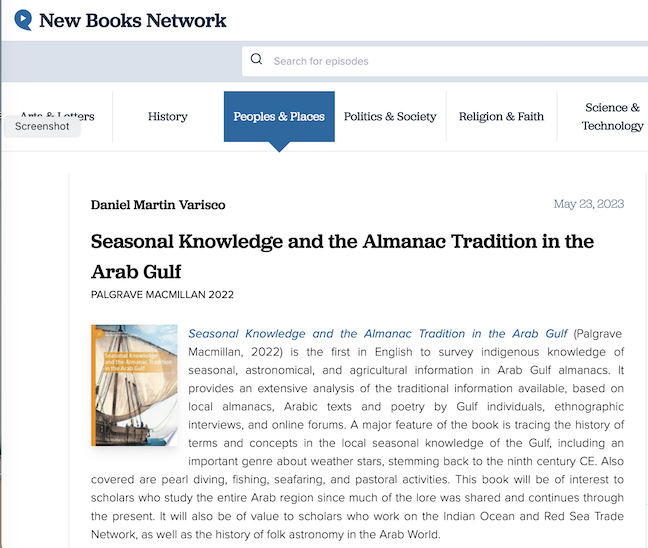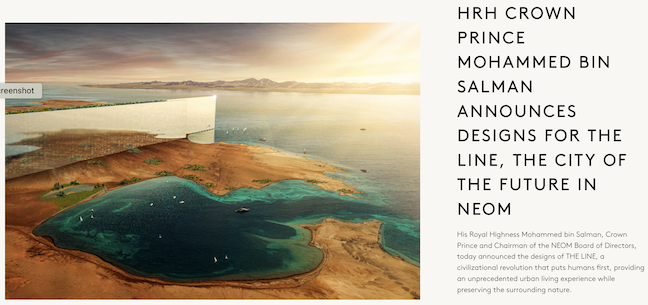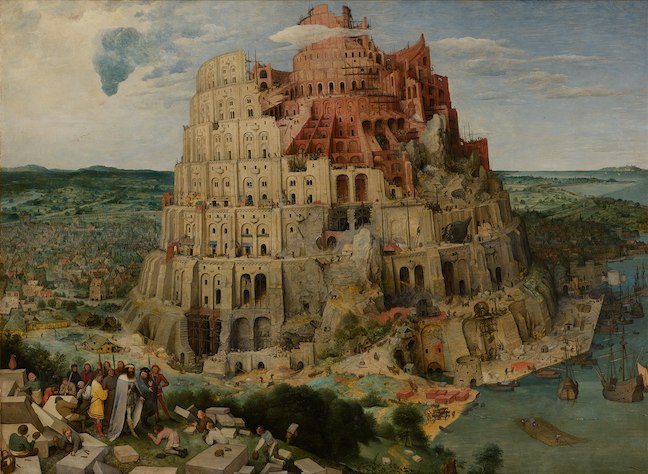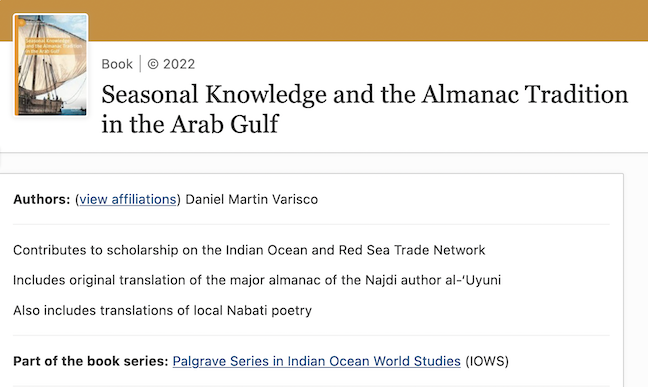
My podcast with Ahmed AlMaazmi and Tamara Fernando is posted online on the New Books Network.

My podcast with Ahmed AlMaazmi and Tamara Fernando is posted online on the New Books Network.

Long before Abraham/Ibrahim left Ur of the Chaldees for the promised land and became the ancestral icon of Judaism, Christianity and Islam, there was that architectural wonder called the Tower of Babel. As noted in the eloquent phrasing of the King James Version of Genesis 11:4: “And they said, Go to, let us build us a city and a tower, whose top may reach unto heaven; and let us make us a name, lest we be scattered abroad upon the face of the whole earth.” Readers of the text know what happened with that bravado venture. As a refresher, here is how the artist Pieter Bruegel the Elder imagined that ziggurat tower in 1563.

Now what if instead of a massive tower, such an old-fashioned idea, a new world wonder was created with the narrow ribbon of an artificial skyscraper city some 75 miles long, and some 656 feet wide? One set of plans would make this the most eco-friendly living space ever conceived:
THE LINE will eventually accommodate 9 million people and will be built on a footprint of just 34 square kilometers. This will mean a reduced infrastructure footprint, creating never-before-seen efficiencies in city functions. The ideal climate all-year-round will ensure that residents can enjoy the surrounding nature. Residents will also have access to all facilities within a five-minute walk, in addition to high-speed rail – with an end-to-end transit of 20 minutes.
This rival to The Pyramids would reach 1600 feet into the sky, thus becoming taller than the World Trade Center that several Saudi citizens destroyed in 2001 by crashing an airplane into the building. Of course such a major building enterprise would cost a lot of money, like a trillion dollars. I wonder what country would have that kind of funding available and what kind of resurrected Nimrod would think of such an idea?
Guess what? The plans are now on the board with the NEOM project known as “The Line”. You can read all about it on all kinds of websites, like NPR, The Independant, The Guardian, Time Out, and many other sources by typing “NEOM The Line” into Google. The patron of this marvel is His Royal Highness (I guess the Highness in his title inspired the idea to have the highest city in the world) MBS of the Kingdom of Saudi Arabia. It would have been nice to read a review of this fiasco by the Saudi journalist Jamal Kashoggi, but he is no longer around.
Of all the places on earth, where would be the best location for this ethereal construction project? Why not at the crossroads of the planet? Now that all roads no longer lead to Rome, I guess that would be the Arabian desert in Saudi Arabia. After all who would not want to live in a natural setting with miles and miles of sand and rocks and hardly any sign of wildlife? Unfortunately there are only a few camels left in the Saudi desert, since most are now getting ready for beauty pageants. But at least there will not be the nuisance of fast-driving joy-riding by Saudi youth through the streets, since there will not be any streets. Instead, I suspect that people will get around by doing what they did on the TV show The Jetsons. Of course, Saudi lifestyles will still be enforced, so women will need a male escort and be veiled before taking that five-minute walk to anything they desire.
World reaction to this marvel of marvels is just beginning. Carlos Felipe Pardo informed NPR that “This solution is a little bit like wanting to live on Mars because things on Earth are very messy.” The choice of Mars is proper, since Venus would not be a good metaphor for Saudi censors due to all the naked images of the goddess Venus that are available on the web. I think there would be a positive response from endangered dictators like Vladimir Putin, since the Saudi government has given sanctuary to all kinds of nasty rulers in exile in the past, most recently Ben Ali of Tunisia. Idi Amin, the brutal ruler of Uganda, but clearly thought to still be a good Muslim in the Saudi style, spent his latter years in luxury as a guest of the Saudis.
The Tower of Babel was doomed from the start, but then Nimrod and his like did not realize the vast oil and gas wealth underneath their feet in the Middle East. If they had, we would all be speaking the same language that Adam and Noah spoke. Even Star Trek never imagined that.
I am pleased to announce the publication of my new book: Seasonal Knowledge and the Almanac Tradition of the Arab Gulf. Details about the book, including a free online pdf of the table of contents can be obtained here: https://link.springer.com/book/10.1007/978-3-030-95771-1

Below is the start of the Introduction…
Before the middle of the twentieth century, everyday life in the Arab Gulf was oriented to the sea and the land. Along the coast and for the island of Bahrain there had been a thriving pearl diving industry until the 1920s, while fishing remained one of the most important food production activities. Trade around and beyond the peninsula was still largely carried out by traditional dhows. Apart from Oman, which has a long tradition of irrigated and rainfed agriculture, most of the Gulf states faced a harsh, arid environment with limited water and only a few fertile oases. Herding of camels, sheep and goat was one of the main ways of surviving in the arid areas. It should not be surprising that prior to the oil wealth that created a lush economic transformation, the main topic of concern was the weather. Successful navigation, pearl diving and fishing required an intimate knowledge of seasonal change, as did pastoralism and farming.
Information on the seasonal sequence for the Arabian Peninsula stems back over a thousand years in collections of poetry, star lore and almanacs. One of the most important Arabic texts is the Kit?b al-Anw?’ (Book of Weather Stars) of Ibn Qutayba (d. 276/879), who is quoted by almanac compilers in the Gulf to this day. Ibn Qutayba describes in detail local knowledge about star risings and settings, weather seasons, pastoral activities, agriculture and a range of environmental conditions. Unfortunately, much of this indigenous heritage has disappeared, as the folklore of generations is now rarely passed on orally within families. In recent years older individuals in the Gulf have written memoirs, preserving their knowledge of life before the Petro Utopia. This gives us a glimpse of the past, a puzzle with many missing pieces, but not the full understanding that comes with actual contact.Resurrecting the history of seasonal knowledge in the Arab Gulf and the entire Arabian Peninsula thus requires a textual archaeology. It is not enough to simply document what is written, as though one is showing off museum objects; this knowledge needs to be placed into a lived context to have a better understanding of how people went about their lives off the land and on the sea.
The past is like an ocean in which we can sample only a small part of the vast number of ideas and customs that have passed by over the years. To follow this metaphor, most of our sampling is along the shore, learning from individuals we can ask directly or engage with in ethnographic fieldwork. We can only cast our research net a short distance in trying to reach back into what really happened and was said in the past. A historian can sail as well, dropping an anchor where there seems to be something worth exploring. But there are depths in this ocean of knowledge that can never be reached. There are also reefs, barriers that make it difficult to have smooth sailing through our disciplined search for the past. To what extent can we know what local knowledge was shared? Then there is the question of what kind of fish we are trying to catch. Is everything that has been done and said, no matter how many generations back, something we should call “heritage”? If we read about it in a book, even one written centuries ago, does that automatically make it “heritage”? How can we vouch for the accuracy of what has been written down when we cannot see it for ourselves or question the interpreter? These are not insurmountable hurdles, but they do caution us to recognize the limitations of reconstructing the past.
My career as a scholar began in the highland mountains of Yemen, where I carried out ethnographic research on traditional water resource use and local agriculture in the late 1970s. Talking with farmers and observing their work for over a year allowed me to gain an understanding of local practices that no book could give me. While in the field I had access to a fourteenth century Yemeni agricultural text, which described many of the agricultural activities I was seeing for myself. My first book was an edition and translation of a thirteenth century Yemeni agricultural almanac. Over the years I have become what is best called a historical anthropologist, someone who looks at heritage as a product evolving from a past and not simply what one sees, without hindsight, functioning in the present. As an anthropologist I focus on the diversity of what people do and say, giving voice to them rather than plugging them into an outside theoretical package from the start. As a historian I have an opportunity in examining texts to see the strands of past knowledge that survive and still influence the present.

This exquisite film was produced in 1973 and filmed in 1972, thus representing Yemen half a century ago. It is now available on Youtube. The filmmakers were Karen and Alain Saint Hilaire. The camera was a bolex ebm electric. It has filmed when Qadi al-Iryani was the head of government. There are scenes from the Tihama, Sanaa, Sa‘da, Ma’rib, etc, including many crafts, fishing, agriculture, a funeral, celebration of the end of the civil war and much more. It is well worth spending two hours to watch this archival film of a Yemen now largely past but not forgotten.


My friend, the historian G. Rex Smith, has recently translated into English a marvelous travel diary by the French military official and traveller Pierre Loti (1850-1923). It is also available on Amazon as a Kindle Book. This day-by-day diary details Loti’s trip along the caravan trail of 1900 from the coast at Bushire to Shiraz and his ultimate goal of Isfahan in order to visit the area during the season of roses. One might expect such an account to be dry, but Loti comments on what he saw, including the people, along the way and one gets a first-hand sense of what it was like to travel a treacherous route that was at times over pure desert and at other times up or down seemingly impenetrable mountain heights. There is also a brief account of his stop at Muscat on the way to Persia. Smith, with the aid of his son, has done an admirable job in reflecting the flavor of the original French and includes 24 photographs taken by Loti. This is a book well worth reading, whether you are interested in Persia at the time or not.
The original French version is available as a pdf here. Archive.org has quite a few of his works.
For information about Loti online, check out https://biography.yourdictionary.com/pierre-loti and https://museeprotestant.org/en/notice/pierre-loti-1850-1923-2/.
The image above, a drawing from the 1850s, epitomizes how the camel has been imagined for everyone in America, the West and just about everywhere outside the area where camels were important domestic animals. A turbaned man astride a galloping camel: Orientalism has ruled the day. And when Westerners visited the Middle East, riding a camel became a touristic must-do, as in the image below:
Camels (the one-humped kind) do exist outside the Middle East, including the Old West of the United States and Australia. But take a look at the next picture of two warning signs. One is from Qatar, where camels sometimes cross a rural road, and the other is from the Amish country in Ohio. The Amish are a group who came to America to escape persecution in Europe and maintain an old lifestyle without electricity or automobiles. I used to visit the Amish parts of central Ohio when I was a child and it was always a game to see who could spot the first Amish buggy. So, I would have been quite shocked to see a camel warning in Ohio.
But today it may be necessary, since the Amish are now raising camels for milk, an idea sparked by a Saudi that led to a company, Desert Farms, being formed in 2015. The prices are a bit out of reach at $18 for 16 ounces of fresh camel milk or $72 for 200 grams of powdered camel milk. But as the site exclaims, camel milk is halal and even if not really kosher, it can be at times.

So if you can afford it or find it (and good luck at that), drink up.

I am a fan of 19th century lithographs of images about the Middle East. One of the books with a plethora of such images is Story of the Bible Animals by the Rev. J. G. Wood, published in 1888 and available on archive.org. In the 700 pages of this book, the largest space (pp. 248-290) is devoted to the camel, drawing on traveler accounts. It is a fun read, full of all the Orientalist prejudices you might image. For example:
“As to the movement of the animal, it is at first as unpleasant as can be conceived, and has been described by several travellers, some of whose accounts will be here given. One well-known traveller declares that any person desiring to practice Camel-riding can readily do so by taking a music-stool, screwing it up as high as possible, putting it into a cart without springs, sitting on the top of it cross-legged, and having the cart driven at full speed transversely over a newly ploughed field.”


